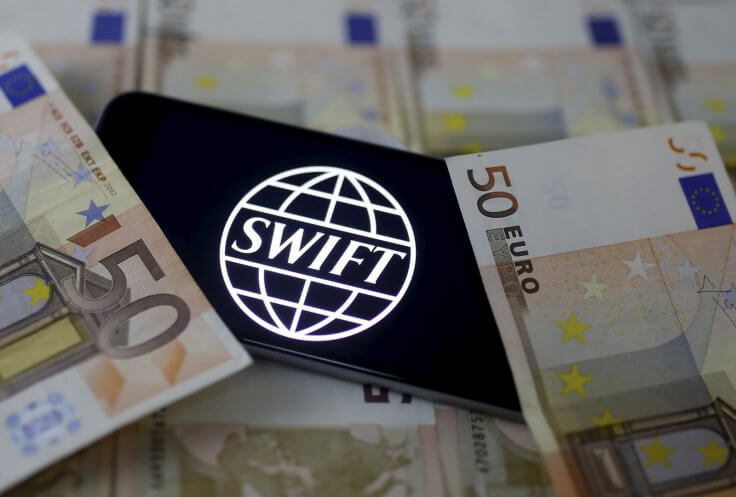Listen to this podcast on Spotify, Apple Podcasts, Podbean, Podtail, ListenNotes, TuneIn
Season 1, Episode 71
Host: Deepesh Patel (DP), Editor, Trade Finance Global
Featuring: Marcus Hughes (MH), Head of Strategic Business Development, Bottomline

Today we’re talking about messaging, humans might use WhatsApp or messenger. Computers might use application programming interfaces, or APIs. Dogs bark at each other, dolphins message through using soundwaves. But what about banks? How do banks message one another?
Often banks need to talk to each other, confirming beneficiaries, recipients, payment amounts, and details of goods and services of their clients and transactions. SWIFT is the financial industry’s neutral and trusted infrastructure provider, and is still moving towards the creation of frictionless instant payments in an ever-changing and complex environment. Today, we’re talking about the evolution of SWIFT.
How has SWIFT changed, what challenges have they faced and how will they continue reinventing themselves in the highly competitive global payments market?
SWIFT’s growing resilience
DP: Can you provide our listeners with a concrete example of SWIFT’s resilience?
MH: Yes, with pleasure. About 4 years ago when some of the cryptocurrency payment providers appeared on the scene a number of commentators predicted that exciting new entrants like Ripple would “eat SWIFT’s lunch” and capture a large share of their core market for cross-border payments. But this revolution has still not materialized.
This is probably due to a number of factors, such as the volatility of cryptocurrencies which probably makes them more attractive as speculative investments rather than as a payment method. Another obstacle to the adoption of cryptocurrency payments are the regulatory concerns about Anti Money Laundering breaches and financial crime. But, in fairness, we should also recognize that a major factor was that, when it found itself under threat, SWIFT came out quite quickly with strong defensive play. This was the beginning of the now well-known gpi program.
gpi stands for Global Payment Innovation, although the industry has now almost universally adopted the acronym Gpi. This initiative was launched only 4 years ago but it is already enabling faster, more easily traceable and more transparent cross-border payments, and on a large scale. Gpi’s traction and success have been highly impressive. To the point that, for me, gpi is probably the single most important initiative by SWIFT in the last 15 years.
The statistics are impressive: gpi has been widely embraced by the banking industry, with over 4,000 institutions either live or committed to be live in the near future. Nearly 70% of SWIFT’s cross-border payments are now being sent via gpi, and a Universal Confirmations mandate was successfully introduced in November 2020. What’s more, nearly 40% of gpi payments are credited to the beneficiary in 5 minutes or less and well over 90% are credited in 24 hours. That’s not bad at all compared to the 2 to 4 day settlement times of just a few years ago. This improved efficiency brings significant benefits to banks and businesses, in terms of speed, reliability and predictability. So, at last I hope we can see an end to those old complaints that SWIFT cross-border payments are very slow and opaque.
It’s also worth mentioning that analysis of gpi data reveals that, in those cases where payment delivery is still delayed, it’s mainly due to factors outside of the direct control of the SWIFT interbank payments model. For example, these delays can be caused by regulatory requirements, local foreign exchange controls, time zone differences and the different business days and business hours of banks around the world.
The role of SWIFT in real-time cross-border payments
DP: What role does SWIFT play in real-time cross-border payments?
MH: Good question. For years the big promise about cryptocurrencies (apart from their attraction to speculative investors!) has been instant cross-border payments. But for various reasons, such as their volatility and regulatory concerns about AML and financial crime, cryptocurrencies have been unable to go mainstream as a real-time payment instrument.
On the other hand, SWIFT have their own real-time payment initiative, known as gpi Instant, which has been making positive progress. SWIFT have been testing with Australia’s NPP and Singapore’s FAST, which are those 2 countries’ real-time payment systems. And now a similar arrangement is available in the UK: I think Lloyds was the first bank in this country to offer SWIFT gpi connected into the UK’s Faster Payments Service.
Cross-border payments from anywhere in the world, destined for the UK, and routed through Lloyds, can now arrive within seconds, with clarity on fees and predictability on when the end beneficiary’s account will be credited. SWIFT’s gpi Instant service has significant potential to be a game-changer in cross-border payments.
But SWIFT certainly aren’t resting on their laurels. They have ambitious plans to make all cross-border payments more efficient, with higher levels of straight-through processing and greater speed. In this respect, SWIFT is playing a key role in the major industry migration to a new messaging format known as ISO 20022.

Increased efficiency in payments
DP: Will this new format lead to more efficient payments?
MH: Yes, certainly. There’s an important change program going on in payment systems around the world. The message schema, known as ISO 20022, is now globally accepted as the best way to standardise and modernise payments and financial messaging. Global adoption of this “network independent” standard will make interoperability between payment systems so much easier.
To deliver this objective, there is an ambitious global migration over the next 4 years to adopt this new format in the world’s principal payment systems; that’s including of course SWIFT’s global financial messaging network. So, the new format is going to have an important and highly positive impact on all types of payments.
The most important thing to remember is that the switch to ISO 20022 will allow payments to carry a great deal more structured data, as well as standardizing payment formats that were previously inconsistent, and much less structured. And the key point is that this structured data is machine-readable, so it does not require any human intervention.
A major reason why regulators are keen to see widespread adoption of this new format is that it will make it easier to automate compliance with Anti Money Laundering requirements. This will help in the fight against Fraud and Financial Crime. The ISO 20022 format has many structured fields which can be made mandatory for including important details, such as the name and address of the ultimate beneficiary, the originator and, of course, any intermediary banks. This means payments that use this format can include all the information necessary to comply with FATF 16 requirements and the EU Wire Transfer Regulations. Comprehensive, structured data will greatly improve automation and reduce the number of false positives when screening payments against sanction lists and watch lists. This improvement will reduce those frustrating delays in cross-border settlements.
Another major advantage is that the new format will significantly increase efficiency. This will result in lower processing costs and higher levels of straight-through processing. The increase in structured information carried in a message will make it easier to track payments in real-time across multiple banks and different payment systems.
The new format will also reduce the risk of errors since users will be able to include additional payment details and references. Using rich data in a structured way will also make it much easier for parties receiving payments to achieve higher levels of automated reconciliation and cash allocation. This in turn will enable a much richer level of data analytics and insights about why payments are made and to whom.
The use of MT FIN messages during the ISO 20022 transition
DP: Yes, the ISO 20022 transition is one of the hottest topics in trade and treasury right now. Perhaps the holy grail for standardisation. What about MT FIN messages? Will these still be used during the ISO 20022 migration period?
MH: For the duration of the migration, MT FIN and ISO 20022 messages will co-exist for 4 years until November 2025. At that time, SWIFT support for MT 100, 200 and 900 series message types will end. At present, no end date has been set for the securities messages, that’s category MT 500, nor the trade finance messages, which are the MT700 series.
In fact, as evidence that SWIFT’s MT FIN trade finance messages will be with us for some time to come, in November this year, SWIFT is making some significant changes to the existing MT 700 series messages and is adding further message types. This is the second phase of the wider initiative to bring SWIFT messaging standards in line with business and market changes. One of the most notable changes is that MT700 and 701 messages will no longer be used to issue Standby Letters of Credit. Instead, extended and more structured MT760 and 761 messages will be used to issue Standbys and Guarantees. These new messages will make Standby and Guarantee issuance and amendments more highly structured, which will improve operational efficiency.

SWIFT’s new solutions
DP: Can you provide a few examples of some of the new solutions and initiatives that we are likely to see from SWIFT?
MH: In July, SWIFT announced they’ll move into low-value cross-border payments, sometimes known as remittances. This initiative is called “SWIFT Go” and is targeted at consumers and small businesses. SWIFT Go enables them to send near real-time payments anywhere in the world direct from their bank accounts. What’s more, half a dozen banks like BBVA, Bank of New York Mellon, Société Générale and UniCredit, are already live with the service.
By using tighter service level agreements between banks and pre-validation of payment data, Swift Go enables banks to provide their end customers with a fast and predictable payments experience. This includes upfront visibility of processing times and costs. This new product is actually a direct response to the needs of small businesses and consumers for fast, easy, predictable, secure and competitively priced cross-border payments. SWIFT Go’s processing fees have to be agreed upon between financial institutions upfront in order to provide customers with full transparency on costs.
Traditionally, SWIFT has been associated with high-value cross-border business payments for banks and large corporates, so the plan to move into cross-border payments for small and medium-sized businesses, and consumers, should help banks win back business which some of them have lost in recent years, due to increased competition from non-bank cross-border Payment Service Providers, which have specialized in this low-value payment space.

The impact of COVID-19 on supply chains and cash flows
DP: Turning to trade finance, the pandemic has highlighted the many fragile points of global supply chains. The UK is currently experiencing an unprecedented HGV driver shortage that is having repercussions country-wide. In your experience, what steps are being taken to digitize these supply chains and improve cash flow for suppliers?
MH: This is an important topic. Covid-19 has definitely generated a greater sense of urgency, far more immediate than ever before, regarding the need to digitize trade finance, the sooner the better.
During the pandemic, we had worrying situations where the release of goods by customs and warehouse controllers was delayed, and the provision of finance was slow. Ridiculously, this was sometimes simply because the required paper trade documents were received late, or it was stuck in the office, sitting on the desk of someone who was actually working from home. Fortunately, in other more successful cases, quick fixes were implemented, using conventional but effective technology.
For example, Optical Character Recognition (or OCR), which is used to scan and distribute documents electronically. This simple but effective solution meant that trade-related documents could be checked by banks’ operational staff even if they were working from home, without any need to go into the office. We all agree that it would of course be far more efficient if these vital trade documents could be exchanged as structured data in a machine-readable manner.
In this way, the pandemic has been a major catalyst to drive the need to reduce paper friction in trade finance and digitise the exchange of letter of credit documentation, such as paper invoices and transport documents, like bills of lading. Solutions do exist, some of them based on blockchain technology. But they haven’t yet achieved the widespread adoption that is needed.
The importance of parternships
DP: With technology comes partnerships, particularly in this continuously changing business environment. How have SWIFT’s business partnerships and relationships evolved over the years?
MH: For years, SWIFT have relied on their partners to connect a growing number of banks and corporates to the SWIFT network. Under one model, this can be the provision of professional services and local support for banks and financial institutions using on-premise SWIFT solutions.
On the other hand, and increasingly popular, is the SWIFT service bureau model which provides outsourced cloud-based applications and expertise to make it easier, faster and more cost-effective for SWIFT users to connect to the SWIFT network, and to operate securely and efficiently. This era of strong partnerships saw SWIFT expand its financial messaging network globally and grow its membership to more than 11,000 entities. Up to a third of these banks and corporates were supported by SWIFT service bureaux. And just to give a sense of the SWIFT network’s massive scale, in total, their messages represent an average of 6 trillion US dollars of value, each and every business day.
But with the introduction of the SWIFT Alliance Lite product range some 10 years ago, those SWIFT service bureaux which only provided connectivity found themselves in direct competition against their partner SWIFT. This resulted in an ambivalent relationship and a strange form of co-opetition between these organisations.
SWIFT’s criteria for SWIFT service bureaux have become increasingly stringent, especially when they introduced the Shared Infrastructure Program. This has progressively become more demanding as higher levels of accreditation are introduced by SWIFT. As a result, a number of bureaux have simply not applied or failed to qualify for accreditation.
At the same time, we have also seen a period of significant market consolidation during which successful SWIFT service bureaux realized that in order to survive they had to provide more than just SWIFT services and connectivity. The number of SWIFT service bureaux around the world was as high as 140 in 2011, but it is striking that numbers have subsequently dropped by a third to just 94. It’s also important to note that more than 15 of these remaining bureaux now actually belong to just 5 large payment software providers, including Bottomline.
So, the nature of SWIFT service bureaux has been through a major transformation in recent years. Many of those bureaux which now belong to the large payment software providers are offering a far broader range of solutions. This helps them to differentiate themselves from SWIFT. They’ve developed a stack of applications in the cloud that can meet bank and corporate customer needs, way beyond pure connectivity to SWIFT.
These value-added services include access to other payment systems and protocols, such as domestic real-time payments systems, which tend not to use the SWIFT network. Another example is connectivity to the new Visa B2B cross-border payments network which is emerging as a competitor to SWIFT and provides banks and corporates with a worthwhile alternative to SWIFT.
These large SWIFT service bureaux belonging to payment software providers also provide other forms of network connectivity, such as Host-to-Host links and of course EBICS, the widely used European protocol. And their cloud-based applications span treasury management systems and payment hubs, as well as payment fraud prevention, and AML sanction screening. What’s more, they’re also using advanced technologies, such as machine learning, predictive analytics and artificial intelligence.

SWIFT’s straetgy
DP: I do like the term co-opetition! What can you tell us about SWIFT’s strategy going forward? How are they going to ensure they remain relevant in a world where domestic and cross-border payments are becoming faster and more efficient?
MH: Yes, this question is central to SWIFT’s future plans. At the core of SWIFT’s strategy moving forward is an ambitious plan to evolve from pure financial messaging to a more sophisticated end-to-end transaction management.
SWIFT is moving away from simply exchanging messages between banks, in series. Instead, they’re planning to introduce processing capabilities on a central platform that will orchestrate payments, based on a central golden copy of all transaction data. Banks will therefore exchange transaction data with the central platform, instead of sending it to the next party in the payments chain for a cross-border payment. This will make cross-border payments faster and more efficient.
SWIFT’s new platform will therefore be known as Transaction Management Platform. This major initiative was endorsed by the SWIFT board in September 2020 and it’s set to launch in November 2022. SWIFT’s objective is for this new platform to deliver “instant, frictionless payments,” thanks to its new transaction management capabilities.
The new platform will have a new centralized data model, using ISO 20022. One of the key challenges with the current SWIFT messaging infrastructure is that their legacy MT FIN messages have limited fields for payment information. Today, MT FIN messages’ restricted field space sometimes requires manual intervention and repairs. All this gives rise to challenges in identifying missing or incorrect information. These fragmented processes can also result in data truncation across various payment systems. This means data gets left out of messages because there’s not enough field space in legacy formats so that parties receiving these messages later in the chain do not receive a complete data set.
But SWIFT’s Transaction Management Platform solves these issues relating to data structure and limited space, thanks to ISO 20022. As mentioned, another important innovation is that instead of payments information being passed sequentially, that is point-to-point between participant banks, the new SWIFT platform centralizes payments information on its cloud infrastructure and gives all participants along the payment chain instant access to all necessary information for payment processing and settlement. Under this innovative model, a golden copy of the payment message is stored in SWIFT’s new platform for each bank to access when they need to. This resolves any problems with truncation.
A key feature of the new platform is that it will be backwards compatible with current MT FIN messaging standards. Although the native format of the platform will be ISO 20022, users can continue to use the MT format to send payment messages to the platform until the ISO 20022 migration deadline for cross-border payments in November 2025. Meanwhile, more advanced banks can adopt ISO 20022 more quickly and communicate with the platform via APIs.
This means that the golden copy approach will enable banks that are on different stages of their migration to ISO 20022 to interact with each other, seamlessly. This will reduce the need for translation services. And banks will be able to absorb a richer data set for streamlining their message processing. This is a major innovation as it will make migration to ISO 20022 easier for cross-border payments, as well as integration with domestic RTGS and ACH systems.

APIs: a key element in SWIFT’s new Transaction Management Platform
DP: APIs are already widely used in the industry, however, do you believe SWIFT’s new Transaction Management Platform will lead to even greater use of APIs?
MH: Exactly, the plan is that APIs will play a key role on SWIFT’s new platform, making interactions between banks more dynamic and real-time, available 24/7. It’s intended that the Transaction Management Platform will use APIs to provide valuable functionality like pre-validation and real-time query resolution.
SWIFT’s current FIN MT “store and forward” messaging is unable to offer this dynamic, real-time functionality. APIs are designed for an immediate call and response, based on a predefined set of protocols and operations. So they are better suited to providing an instant, real-time, 24/7 experience than the current sequential MT FIN messaging flows.
So, SWIFT’s Transaction Management Platform APIs will enable bilateral and multilateral communication in real-time. This will be a key element of the 24/7 payments experience. What’s more, this API-based model will be significantly more efficient than the current model. That’s because it’ll use predefined, action-oriented API calls and responses.
With the 2 key elements which I’ve mentioned before, that is an enriched ISO 20022 data model and real-time API connectivity with participants, SWIFT will be so much better placed to coordinate payments more efficiently. This effectively means they will be able to “line up” a series of banks in a payment chain and achieve a synchronized settlement process, based on message pre-validation. Making full use of SWIFT’s new dynamic API interaction, they will be able to arrange a payment across multiple banks and then orchestrate instant or near-instant end-to-end settlement.
All this change represents a radical transformation of SWIFT financial messaging today. And it will mean that payment issues are identified and addressed before release and therefore provide greater confidence for the payer that funds will be credited to the recipient in real-time. This exciting approach has tremendous potential to dramatically change the world of cross-border payments.
Once this modern infrastructure is in place, SWIFT is looking at becoming a marketplace where banks and other participants can access services from SWIFT itself and its fintech partners. This is expected to include a wide range of services, like fraudulent payment prevention and AML compliance checks.
The future of SWIFT
DP: What is next for SWIFT at a high level?
MH: SWIFT have exciting ambitions, including the creation of a central role for itself in the hot topic of Central Bank Digital Currencies. I do sense that the market is reaching the next level in the evolution of blockchain and crypto assets, especially relating to digital currencies. Recent work by various central banks means it is increasingly likely that quite soon one or more major central banks will issue their own Central Bank Digital Currency.
Although a few small economies like the Bahamas have already launched their own local Central Bank Digital Currency, we’re now seeing the central banks of several major economies announcing initiatives to test or even create their own digital currency. In the meantime, other central banks want to make sure they are ready on the sidelines, just in case adoption gains rapid traction.
Ironically, the hype and controversy around Facebook’s Libra stablecoin, rebranded as Diem some months back, has actually made the launch of a Central Bank Digital Currency more likely than ever. So, for me, it’s now more a question of “when”, not “if”, a central bank launches a digital currency.
A number of central banks are quite advanced in exploring the best way to approach digital currencies, and which model to adopt. For example, the central bank of Sweden is quite advanced in developing a retail e-Krona, which may be one of the early adopters. Similarly, the Bank of England and the European Central Bank have their own separate initiatives. But it’s the People’s Bank of China that is most advanced of all. They’ve been holding large scale pilots for their e-yuan in various cities across China, such as the massive tech hub Shenzhen, just across the border from Hong Kong.
Use cases that have been tested are bill payments, transport, shopping, and government services. And, it looks increasingly likely that China will launch its e-yuan at the Beijing Winter Olympics, starting on 4 February 2022. So exciting times ahead. For me, after many years of experimentation and seeing huge sums of money invested in blockchain, Central Bank Digital Currencies are now emerging as one of the most exciting and practical applications of this new technology.
And as you’d hope, SWIFT see a “unique role” for themselves as a multilateral interchange mechanism for cross-border Central Bank Digital Currencies, in multiple currencies. They believe they are also well placed to provide interoperability between CBDC and non-CBDC networks, linking Real Time Gross Settlement systems with CBDC networks. SWIFT are absolutely right in stating that sanctions screening and FATF requirements will apply when exchanging CBDCs, just like fiat currencies. So SWIFT Transaction Management Platform looks well placed to help with this requirement.

































